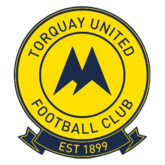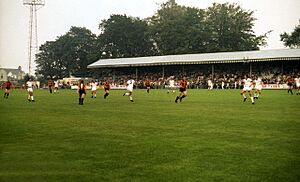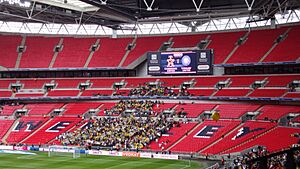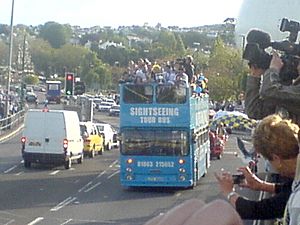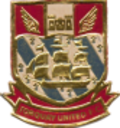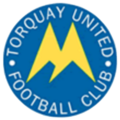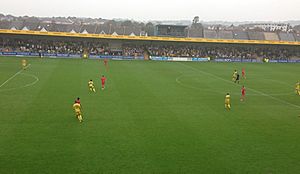Torquay United F.C. facts for kids
Torquay United Football Club is a professional association football team from Torquay, Devon, England. They are known as "The Gulls" because of their seaside location. The team plays its home games at Plainmoor stadium, which has been their home since 1921. Their main colours are yellow and blue.
The club started in 1899. They joined the Football League in 1927 after winning the Southern League title. For many years, they played in the lower divisions of English football. They had some ups and downs, including promotions and relegations.
Torquay United won a play-off final in 1991 to get promoted. They also won another play-off final in 2009 to return to the Football League. In recent years, they have played in the National League South, which is the sixth level of English football. In April 2024, the club faced financial difficulties.
Contents
Club History: The Gulls' Journey
How Torquay United Started (1899–1912)
Torquay United was first formed in 1899 by a group of young people. Their first game was a friendly match against a local cricket team. After playing friendly games, the club joined the East Devon League. They moved to the Recreation Ground for four years.
Later, the club had to move homes a few times. They eventually shared a ground with Torquay Cricket Club. During this time, in 1909, they won their first trophy: the Torquay and District League title. In 1910, Torquay United joined with another local team, Ellacombe Football Club, and became Torquay Town. This is when they finally moved to Plainmoor, where they still play today.
Joining the Football League (1920–1950)
After World War I, in 1920, two nearby teams, Plymouth Argyle and Exeter City, joined the Football League. This made people in Torquay want their own team to join too. So, Torquay Town and another local team, Babbacombe, merged to form a new professional club called Torquay United.
In 1921, Torquay United joined the Western League. Then, in 1922, they moved to the Southern League. In 1927, Torquay won the Western Division of the Southern League. This success helped them finally join the Football League Third Division. Their first Football League match was on August 27, 1927, with a crowd of 11,625 fans.
The team faced financial challenges in the 1930s. They also struggled to finish high in the league table. After World War II, in 1946, the club continued to face difficulties.
Exciting Times and Promotions (1950–1970)
In 1954, Torquay United changed their team colours. They switched from black and white stripes to gold and blue. These new colours were chosen to represent the town's "sun, sand, and sea" image. The club still uses these colours today.
This change brought better luck! In the 1954-55 FA Cup, Torquay played against Leeds United. They drew 2-2 away from home, then won the replay 4-0 at Plainmoor. In the next round, they played Huddersfield Town. The official attendance for that game was 21,908, which is still a club record!
In the 1956-57 season, Torquay almost got promoted to Division Two. They just missed out by a small difference in goals. In 1960, Torquay United beat Gillingham 2-0 and were promoted back to the Third Division. However, they were relegated again in 1962.

In 1963, Torquay signed striker Robin Stubbs for a club record fee of £6,000. He became a top goalscorer. In the 1964-65 FA Cup, Torquay played against the famous team Tottenham Hotspur. In front of over 20,000 fans at Plainmoor, the game ended 3-3, with Robin Stubbs scoring two late goals. Tottenham won the replay 5-1.
After this, Frank O'Farrell became manager. In his first season, Torquay earned their second promotion, finishing third in Division Four. They almost got promoted to Division Two again in 1967-68, finishing fourth. During this time, Torquay fans were even voted the 'Best Behaved Supporters in the League'! Frank O'Farrell left in 1969 to manage Leicester City.
Challenges in the Lower Leagues (1970–1988)
After a few average seasons, Torquay was relegated back to the lowest division in 1971-72. The club spent most of the 1970s finishing in the middle of the league table. Frank O'Farrell returned as a consultant in 1977.
In 1982-83, Torquay reached the fourth round of the FA Cup. They lost a thrilling 3-2 game at Plainmoor against Sheffield Wednesday. In 1984-85 and 1985-86, Torquay finished last in Division Four. They had to ask the Football League to let them stay, and they were successful both times. In 1986-87, the club avoided automatic relegation on the very last day of the season. This happened after a Torquay player was bitten by a police dog, which caused injury time to be added, allowing them to score a crucial goal.
New Beginnings and Wembley Appearances (1988–2008)
In 1987-88, Cyril Knowles became manager. That year, Torquay beat Tottenham Hotspur 1-0 in the FA Cup. They also reached the semi-final of the Football League Trophy. In 1988, Lee Sharpe moved to Manchester United for £180,000, which was a very big transfer fee for Torquay.
Torquay reached the Football League Trophy final in 1989. A crowd of 46,513 watched them lose 4-1 to Bolton Wanderers at Wembley. After being relegated in 1992, they lost another play-off final at Wembley in 1998. However, they earned automatic promotion in 2003-04. Their stay in the higher league only lasted one season, and they were relegated in 2005.
In 2007, Torquay United lost their Football League status after 80 years. This happened after a 1-1 draw at home to Peterborough United. Soon after, a lottery winner named Paul Bristow bought the club.
On March 15, 2008, Torquay played at Wembley again in the FA Trophy final. They lost 1-0 to Ebbsfleet United. However, on May 17, 2009, Torquay United were promoted back to the Football League! They won the play-off final at Wembley with 35,000 fans watching.
From League to Non-League and Back (2008–Present)
In their first season back in League Two (2009-10), Torquay finished 17th. The next season, they reached the fourth round of the FA Cup, matching a club record. They finished 7th in the league but lost in the play-off final. In 2011-12, under new manager Martin Ling, Torquay had a very successful season, finishing second in League Two. However, they lost in the play-off semi-finals.
The club was relegated to the Conference Premier (now National League) in 2013-14. In 2015, a group of ten local business people took over the club. In 2017, a deal was made with a gaming company.
On April 21, 2018, Torquay was relegated to the sixth tier of English football for the first time. But they bounced back quickly! Under manager Gary Johnson, they won the National League South title on April 13, 2019, earning immediate promotion.
In the 2020-21 season, Torquay finished second in the National League. They reached the play-off final, where their goalkeeper Lucas Covolan scored a dramatic equalizer in the last minute! However, they lost the game on penalties. Two years later, Torquay was relegated back to the National League South.
Club Administration (2024)
On February 22, 2024, the club chairman announced plans for the club to enter administration. This means the club was facing serious financial difficulties. The National League then deducted ten points from Torquay, which dropped them down the league table.
The club officially went into administration on April 5, 2024. They were deducted another point for playing a suspended player. Torquay finished the 2023-24 season in 18th place, their lowest league finish since 1927. A group of local business people, called the Bryn Consortium, planned to take over the club. On May 14, 2024, Paul Wotton was appointed as the new manager. The club was no longer in administration by April 25, 2025.
Club Identity: Crest and Colours
Club Crest
Torquay's first club crest was based on the town's coat of arms. It showed a ship, representing the area's connection to the sea. It also had golden wings, which stood for the local seagulls. This crest was used for many years. In the 1970s, the design changed to focus more on the "gulls wings" emblem.
In the 1980s, the club used a circular crest with two palm trees. But in 1986, they went back to the gull emblem, surrounded by the club's name. Over time, there were different versions of this gull crest. So, in 2017, the badge was updated to a cleaner, more modern design.
Team Colours
Torquay United has used different team colours over the years. In the beginning, they played in light and dark blue. Then, they switched to black and white stripes, which made people call them 'the magpies'.
In 1954, the club decided to change its look. They chose bright yellow (or gold) and blue kits. These new colours were picked to represent the golden sands and blue sky and sea of Torquay. Since then, the club has mostly worn yellow and blue. This colour change also led to their famous nickname, 'The Gulls'.
Plainmoor Stadium: The Gulls' Home
Plainmoor's History
Torquay United's first game was played on a farmer's field. After that, they moved to the Recreation Ground for four years. However, they had to move again when the rugby club took over that ground. The team then shared a ground with Torquay Cricket Club for four years.
In 1910, when Torquay United merged with Ellacombe to become Torquay Town, they moved to Ellacombe's Plainmoor ground. This stadium has been their home ever since. On May 17, 1985, a fire damaged the main stand at Plainmoor. Luckily, no one was hurt.
Over the late 1980s and early 1990s, the stadium was greatly improved. A new family stand was built, with a club shop and restaurant. The 'popular side' of the stadium was also covered and updated. In 2000-01, the away end was redeveloped. The old wooden grandstand, which had been there since 1927, was taken down in 2011. A new stand, called Bristow's Bench, was built in its place in 2012.
Future of Plainmoor
After a takeover in 2006, there was talk of moving the club to a new, bigger stadium. However, later chairmen said that the club and fans wanted to stay at Plainmoor. They planned to improve the current stadium instead.
Plans to extend the grandstand were approved in 2011. This new structure, Bristow's Bench, was named after Paul Bristow, who helped the club return to the Football League. The new stand was ready for the 2012-13 season.
More recently, there have been discussions about moving the stadium again. The club's new owners in 2017 were interested in building a new multi-use complex and developing the Plainmoor site for housing. However, these plans have been debated by fans and the local council.
Team Players
Current Squad
|
|
Players on Loan
|
Club Management
Coaching Staff
| Position | Name |
|---|---|
| Manager | Paul Wotton |
| Assistant Manager | Mike Edwards |
| Football Advisor | Neil Warnock |
| Goalkeeper Coach | Kenny Griffiths |
| Sports Therapist & Kitman | Russell Cleave |
| Head of Medical | Regan Miles |
| Video Analyst | Louie Birkenshaw |
| Club Doctor | Dr. Vivek Kulkarni |
Managers Through the Years
|
|
|
Club Records and Achievements
- Highest League Position: 2nd in Third Division South (level 3) in 1956–57.
- Best FA Cup Performance: Reached the Fourth Round seven times.
- Best League Cup Performance: Reached the Third Round four times.
- Best League Trophy Performance: Runners-up in 1988–89.
- Best FA Trophy Performance: Runners-up in 2007–08.
- Record Attendance: 21,908 fans against Huddersfield Town in the FA Cup on January 29, 1955.
- Biggest Victory: 9–0 against Swindon Town on March 8, 1952.
- Heaviest Defeat: 2–10 against Fulham on September 7, 1931.
- Most Appearances: Dennis Lewis played 442 games (1947–1959).
- Most Goals: Sammy Collins scored 219 goals (1948–1958).
Notable Player Transfers (Purchases)
- Leon Constantine from Peterborough United for £75,000 in December 2004 (club record).
- Billy Bodin from Swindon Town for £70,000 in July 2012.
- Eifion Williams from Barry Town for £70,000 in March 1999.
- Robin Stubbs from Birmingham City for £6,000 in 1963.
Notable Player Transfers (Sales)
- Rodney Jack to Crewe Alexandra for £650,000 in July 1998 (club record).
- Matthew Gregg to Crystal Palace for £400,000 in October 1998.
- David Graham to Wigan Athletic for £315,000 in August 2004.
- Bobby Olejnik to Peterborough United for £300,000 in June 2012.
- Lee Sharpe to Manchester United for £185,000 in May 1988.
Club Honours
Source:
League Titles
- Fourth Division / Third Division (level 4)
- Promoted: 1959–60, 1965–66, 2003–04
- Play-off Winners: 1991
- Conference (National League) (level 5)
- Play-off Winners: 2009
- National League South (level 6)
- Champions: 2018–19
- Southern League (Western Division)
- Champions: 1926–27
Cup Honours
- Associate Members' Cup
- Runners-up: 1988–89
- FA Trophy
- Runners-up: 2007–08
- Devon Senior Cup
- Winners: 1910–11, 1921–22
See also
 In Spanish: Torquay United Football Club para niños
In Spanish: Torquay United Football Club para niños


